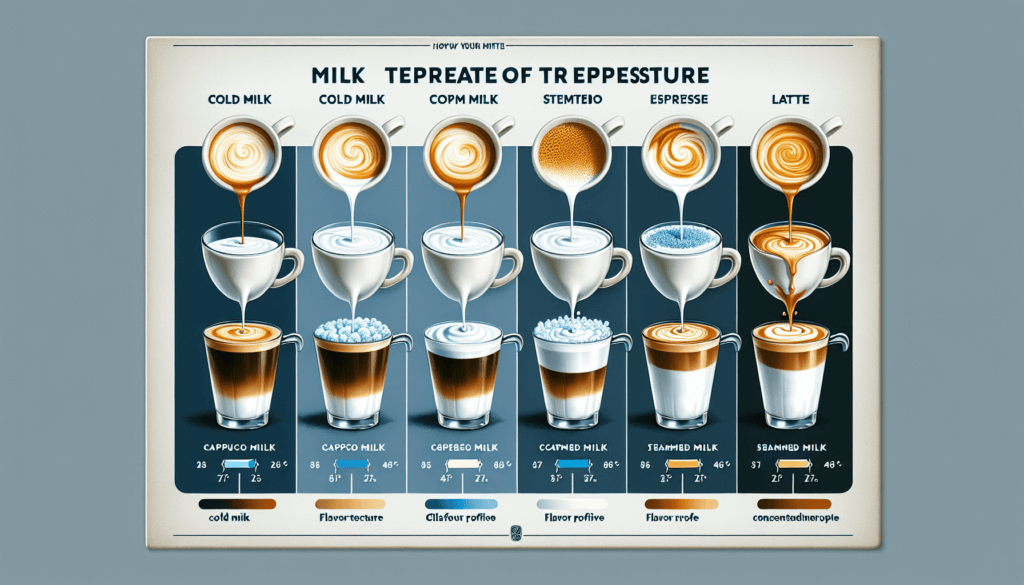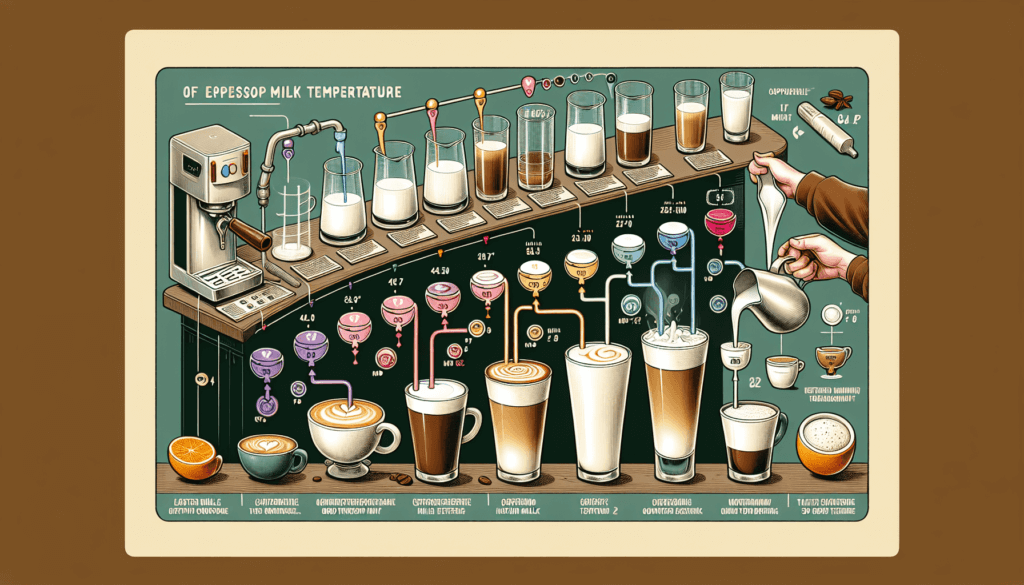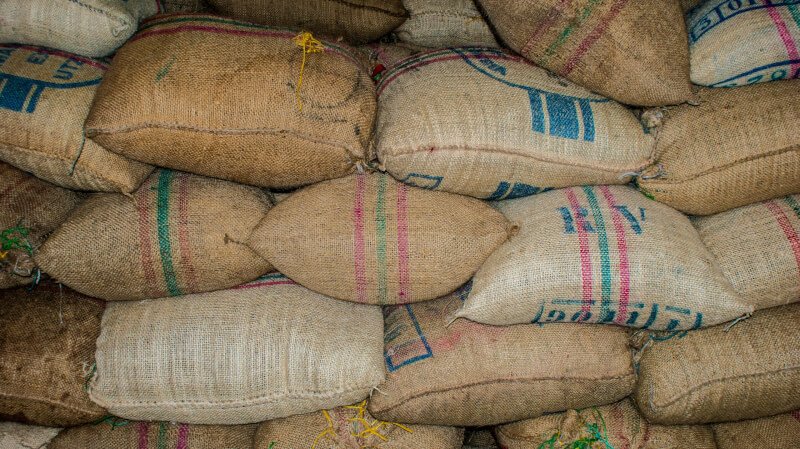Imagine sipping a velvety smooth espresso drink, with the perfect balance of robust espresso and creamy milk. Have you ever wondered what role the temperature of the milk plays in creating this divine harmony? In this article, we will explore the fascinating world of milk temperature and its profound impact on the taste, texture, and overall experience of espresso drinks. Get ready to embark on a journey of understanding as we uncover the secrets that lie within the warmth of your coffee cup.
Why Milk Temperature Matters
When it comes to making the perfect espresso drink, the temperature of the milk plays a crucial role. The temperature directly affects the flavor, texture, and overall quality of the drink. Understanding the science behind milk temperature and knowing the ideal temperature for different espresso drinks is essential for achieving the best results. Additionally, factors such as milk frothing technique, milk quality, and the material of the milk vessel can all influence the milk’s temperature and its impact on the final drink. In this article, we will delve into the importance of milk temperature and explore how it affects various aspects of espresso drinks.
How Milk Temperature Affects Flavor
The temperature of the milk can significantly impact the flavor of espresso drinks. When milk is heated, it undergoes several chemical reactions that enhance its taste. Heating the milk to the right temperature helps to release its natural sweetness and highlight its creamy characteristics. If the milk is too hot, the natural sugars can become caramelized, resulting in a slightly burnt or bitter taste. On the other hand, if the milk is too cold, the flavors may not fully develop, leading to a bland and less satisfying experience. Finding the perfect milk temperature is key to achieving a well-balanced and flavorful espresso drink.

Understanding the Science Behind Milk Temperature
To understand the science behind milk temperature, it is essential to know the role of protein denaturation and sugar caramelization. When milk is heated, the proteins in the milk coagulate, resulting in the foamy texture that is characteristic of espresso drinks. This process, known as protein denaturation, occurs at specific temperature ranges. Additionally, as the milk heats up, the sugars in the milk begin to caramelize, adding depth and richness to the flavor profile. Understanding these chemical processes can help baristas and coffee enthusiasts alike in achieving the desired milk temperature for different espresso drinks.
The Ideal Milk Temperature for Different Espresso Drinks
Different espresso drinks require different milk temperatures to achieve their intended taste and texture. Let’s explore the ideal milk temperature for some popular espresso beverages:
The Perfect Temperature for Cappuccinos
For a classic cappuccino, the ideal milk temperature is around 150°F (65°C). This temperature allows the milk proteins to denature and create the characteristic velvety foam, while still preserving the sweetness of the milk.
Finding the Sweet Spot for Lattes
Lattes typically require slightly higher milk temperatures compared to cappuccinos. The ideal temperature for a latte is around 160°F (71°C). This slightly higher temperature helps to accentuate the rich and smooth flavors of the milk, enhancing the overall experience of the drink.
Temperature Considerations for Flat Whites
Flat whites, which are known for their velvety texture and balanced flavors, require milk temperatures similar to lattes. Aim for a temperature of around 160°F (71°C) to achieve the perfect balance between texture and taste.

Factors Influencing Milk Temperature
Several factors can influence the temperature of the milk and, consequently, its impact on espresso drinks. Understanding and managing these factors is crucial in achieving consistency and quality in the final product. Let’s explore some key considerations:
The Role of Milk Frothing Technique
The milk frothing technique plays a significant role in determining milk temperature. The speed at which the steam wand is introduced into the milk, the angle at which it is inserted, and the level of frothing can all affect the temperature. Consistency in milk frothing technique is vital in ensuring consistent milk temperature across different espresso drinks.
The Importance of Milk Quality
The quality of the milk used also affects its temperature response. Different types of milk, such as whole milk, skim milk, or plant-based alternatives, can have different boiling points and temperature ranges for protein denaturation. It is essential to choose high-quality milk that is fresh and suited to your desired espresso drink.
Influence of Milk Vessel Material
The material of the milk vessel can impact the rate at which the milk heats up and cools down. Stainless steel milk jugs tend to retain heat better than other materials, allowing for more precise control of milk temperature. Understanding the characteristics of different milk vessel materials can help in managing milk temperature effectively.
The Impact of Milk Temperature on Foam Texture
The temperature of the milk is closely tied to the texture and stability of the foam. Achieving the perfect microfoam – tiny, velvety bubbles – requires careful attention to milk temperature. Let’s explore how milk temperature influences foam texture:
Creating Microfoam at Optimal Temperatures
To achieve the desired microfoam, the milk should be heated to a specific range. For most espresso drinks, including cappuccinos and lattes, aim for a milk temperature between 140°F (60°C) and 160°F (71°C). This range allows the milk proteins to denature and trap air, creating the velvety texture and stable foam essential for latte art.
Effects of High and Low Temperatures on Foam Stability
Milk that is heated above the ideal temperature range can result in large bubbles and a less creamy texture. On the other hand, milk that is too cold may not allow for effective protein denaturation and foam creation. Finding the sweet spot within the recommended temperature range is key to achieving the perfect foam stability for latte art and enhancing the overall aesthetic appeal of the espresso drink.

The Influence of Milk Temperature on Espresso Extraction
While milk temperature is often associated with foam texture and flavor, it also plays a role in the extraction of espresso itself. The temperature of the milk can impact the extraction time and, consequently, the flavor profile of the espresso. Let’s delve into this further:
Temperature’s Influence on Extraction Time
When hot milk is combined with espresso, it can cool down the espresso and affect the extraction process. If the milk is too hot, it can cause the espresso to become under-extracted, resulting in a weak and sour taste. On the other hand, if the milk is too cold, it can cool down the espresso too quickly, leading to over-extraction and a bitter taste. Finding the right milk temperature helps to ensure a balanced and well-extracted espresso.
Implications for Espresso Flavor
The temperature of the milk can influence the overall flavor profile of the espresso. Cooler milk temperatures can help to mellow out the acidity of the espresso, making it smoother and more enjoyable. Warmer milk temperatures, on the other hand, can accentuate the brightness and complexity of the coffee. Understanding the impact of milk temperature on espresso flavor allows for greater control and customization of the final drink.
Milk Temperature and Latte Art
Latte art has become synonymous with the artistry and skill of a barista. Achieving the perfect milk temperature is crucial in creating the canvas for intricate designs. Let’s explore the relationship between milk temperature and latte art:
Achieving Latte Art with Warmer Milk
Warmer milk temperatures, around 160°F (71°C), offer better control and more stable foam for creating latte art. The increased temperature allows the milk to be manipulated and poured in intricate patterns without losing its shape or structure. Warmer milk also produces a more pronounced contrast between the milk and espresso, enhancing the visual appeal of the art.
Challenges and Techniques with Cooler Milk
Cooler milk temperatures can pose challenges when it comes to creating latte art. The lower temperature can result in quicker foam dissipation and less control over the patterns formed. However, experienced baristas have developed techniques, such as pouring closer to the surface and utilizing faster pouring speeds, to create stunning latte art with cooler milk temperatures. It requires practice and experimentation to master the art of latte art with different milk temperatures.

Understanding Milk Temperature on Different Espresso Machines
Different espresso machines can have varying capabilities when it comes to controlling and adjusting milk temperature. Let’s explore how to manage milk temperature on automatic and manual espresso machines:
Adjusting Milk Temperature on Automatic Machines
On automatic machines, milk temperature can be adjusted through the machine’s settings. Most automatic machines have pre-set temperature options, allowing you to select the desired temperature for your espresso drink. Understanding the temperature capabilities of your machine and experimenting with different settings can help you achieve the ideal milk temperature consistently.
Controlling Temperature on Manual Espresso Machines
Manual espresso machines require more hands-on control over the milk temperature. The barista must monitor and adjust the position and angle of the steam wand, as well as the duration of the frothing process, to achieve the desired temperature. Practice, experience, and familiarity with the particular machine are crucial in mastering milk temperature control on a manual espresso machine.
The Role of Personal Preference in Milk Temperature
While there are recommended milk temperature ranges for different espresso drinks, personal preference plays a significant role in determining the perfect milk temperature for each individual. Some people may enjoy their cappuccinos slightly cooler, while others prefer them slightly warmer. Experimenting with different milk temperatures allows you to discover your preferred range and create a customized espresso experience.
Different Preferences for Milk Temperature
It is common to find variations in milk temperature preferences among different cultures, regions, and individuals. For example, in some European countries, a cappuccino is traditionally served slightly cooler than in other parts of the world. It is essential to accommodate and respect differing preferences when preparing espresso drinks.
Experimenting with Different Milk Temperatures
To truly find your ideal milk temperature, experimentation is key. Start by trying different temperature ranges and noting the flavor, texture, and overall experience of each drink. Over time, you will be able to refine your preferences and identify the milk temperature that best suits your taste buds. Remember, there is no right or wrong answer – it’s all about finding what you enjoy the most.

Practical Tips for Managing Milk Temperature
Managing milk temperature can be a challenge, but with practice and the right techniques, you can achieve consistent results. Here are some practical tips for mastering milk temperature:
Using Thermometers for Accuracy
Investing in a reliable milk thermometer is a game-changer when it comes to achieving the desired milk temperature. Thermometers allow you to monitor the milk’s temperature accurately and make adjustments as needed. Place the thermometer in the milk jug while steaming to track the temperature and remove it once the desired temperature is reached.
Mastering Milk Steaming Techniques
Milk steaming techniques are crucial in managing milk temperature effectively. Familiarize yourself with proper steaming techniques, such as introducing the steam wand at the correct angle and controlling the frothing process. Practice, patience, and attention to detail will help you master the art of milk steaming and achieve the perfect temperature consistently.
Conclusion
Milk temperature plays a vital role in the overall quality, flavor, and texture of espresso drinks. Understanding the science behind milk temperature, the ideal temperature for different espresso beverages, and the factors influencing milk temperature allows baristas and coffee enthusiasts to create consistently delicious and visually appealing drinks. Personal preferences, experimenting with different milk temperatures, and mastering practical tips for managing milk temperature all contribute to the art and science of achieving the perfect espresso experience. With this knowledge and practice, you can elevate your espresso game and delight your taste buds with the perfect milk temperature in every cup.


